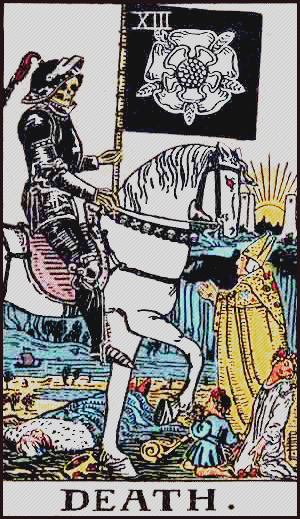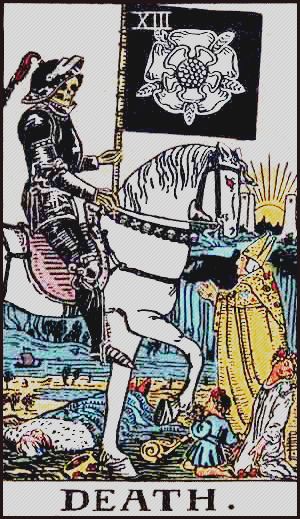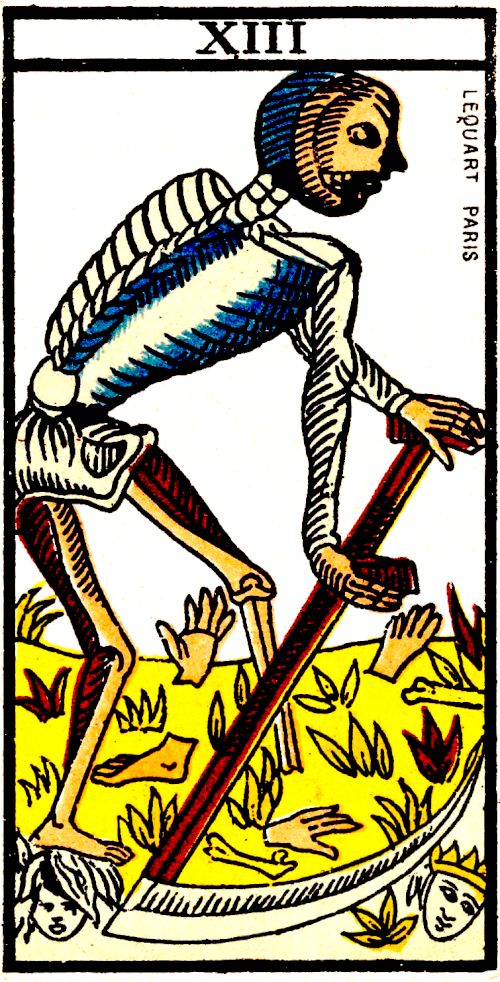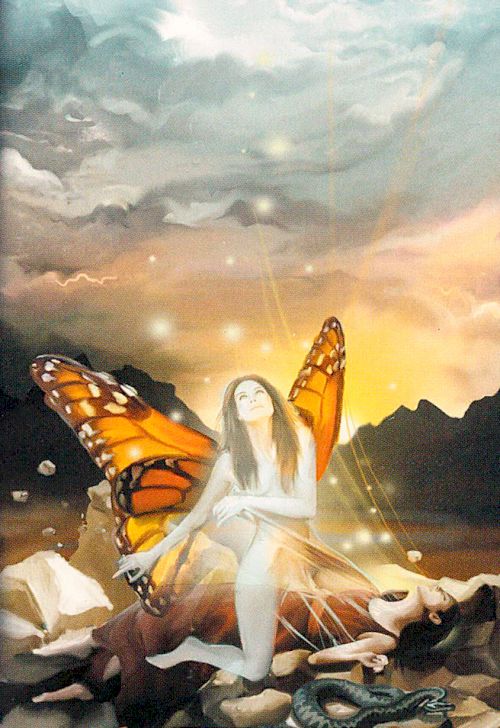
Death Card Tarot: Embrace Transformation & Renewal
April 4, 2025Death card in tarot typically makes people feel anxious. They are afraid to get a tarot reading because they don't want to face the message this card may convey. Death, on the other hand, doesn't usually mean physical death...
Death Card Tarot: What It Really Means
Death tarot card stands for endings and necessary change. This means that coming upon it might be a good omen, since it means there is a chance for growth and rebirth.
Death card frequently means big changes, which can be hard. It tells us to accept the cycles of life, both big and tiny.
Examples of Death Card Symbolism
- The end of a relationship
- The begining of a new job
- A shift in personal perspective
These changes, although they can be difficult, are often necessary for personal growth. Often, many of them occur simultaneously, in different areas of life.
Death Card: Common Myths vs. Reality
Let's look at some frequent misunderstandings to better comprehend what The Death card really means. The table below shows the differences between common misconceptions and the real meanings.
| Common Myth | Tarot Reality |
|---|---|
| Predicts physical death | Symbolizes transformation and change |
| Signifies tragedy and misfortune | Represents necessary endings and new beginnings |
| Should be feared | Offers opportunities for growth and renewal |
The table shows the main difference between what people think The Death means and what it really means. The card reminds us that change is the only constant, and by accepting endings, we create space for new beginnings.
Death Card vs. The Tower Card
You could come to the conclusion that both Death card and The Tower card have the same meaning. However, the difference between them is tremendous.
Death indicates rather an internal transformation, when ending or freeing yourself from something changes your life — it is more of a process, a metamorphosis, a natural cycle. It is about shedding old layers so that personal growth can lead to external change. The Tower, on the other hand, is an external shock or disturbance that shakes your foundations from the outside and often seems to be imposed on you. Only after the fall can you come to some inner understanding or growth.
In short: Death clears what you’re ready to release, The Tower rips away what you weren’t ready to face.
Death Card Tarot Over the Ages
Death card is one of the most misunderstood tarot cards. Over time, its images and meanings have undergone significant changes, reflecting the evolution of people's views on death and change. Looking at this historical path helps us better understand the meaning of this card.
Medieval Influences: Memento Mori and the Macabre
The 15th-century Visconti-Sforza deck and other early tarot decks often showed Death as a skeleton, sometimes on a horse, gathering souls. This concept was directly related to the medieval idea of memento mori — a strong reminder that death is unavoidable.
The memento mori tradition had a big effect on how early Death cards looked. This artistic and literary theme, which was common throughout medieval Europe, stressed how short life is. Early pictures generally showed skeletons, graveyards, and other creepy motifs.
However, these photographs were not intended to frighten anyone. Instead, they encouraged people to reflect on their spiritual lives and to act in accordance with ethical principles. Although focusing on death may seem sad, in reality it was a powerful motivation for spiritual reflection.
Victorian Mysticism and the Shift in Meaning
The Victorian era, with its strong interest in the occult and spiritualism, changed how people thought about Death card. The rise of esoteric groups like the Hermetic Order of the Golden Dawn and a renewed interest in ancient knowledge led to more metaphorical readings.
During this time, the Rider-Waite-Smith deck was made. It is still one of the most important tarot decks in use today. Artist Pamela Colman Smith, guided by occultist A.E. Waite, portrayed Death not as an ending, but as a process of transformation.
The skeletal figure was redesigned as a knight, which is a symbol of change, riding toward the rising sun. This picture didn't mean the end; it was the promise of a new beginning.
Modern Interpretations: Transformation and New Beginnings
Nowadays, Death card is largely seen as a sign of transformation, renewal, and rebirth, even if it still sometimes uses conventional images.
Modern interpretations often focus on the positive aspects of endings, underscoring the prospects that arise upon relinquishing the past. This speaks to people who now read tarot cards and want to learn more about themselves. They are not afraid of the unknown; instead, they are open to the idea of positive change.
Learning Death Card Tarot's Rich Symbolism
In this section, we will examine the intriguing visual language of Death card and the various layers of meaning contained within its illustrations.

The Skeletal Figure: A Symbol of Change
Most pictures of Death card show the skeleton in the very center. But this skeletal shape doesn't mean death in the literal sense. Instead, it stands for the part of us that stays the same after we let go of our old selves.
This suggests that the skeleton symbolizes transformation rather than the end. It means letting go of things that no longer serve us so that something new can come into our lives. It is a clear sign of transition from one phase of life to the next.
The White Rose: Purity and New Beginnings
A white rose is a common symbol on Death card. This charming flower symbolizes purity, innocence, and the promise of a new beginning. It represents purification and renewal, which often follow major changes in life.
Imagine going through a difficult breakup. The white rose can represent the clarity and peace that eventually follow the initial pain. This adds to the main message of Death card, which is about hope and rebirth.
The Fallen King: All Are Equal
Another common image is that of a fallen king or other authority figure. This emphasizes that symbolic death is an equalizer. It affects everyone, regardless of status or power.
This picture shows that change is inevitable and affects everyone equally. It teaches to be humble and open-minded when life circumstances change.
The Flag and the Rising Sun: A Journey of Hope
The skeletal figure usually carries a flag with a mystical symbol on it. The flag stands for the journey of the soul, which means that we are always changing and growing as we go through life.
The rising sun in the background adds another layer of meaning. This sunrise symbolizes new beginnings that follow endings, reminding us that light always returns after darkness. It conveys a powerful message of optimism and comfort.
Death Card Tarot's Message Changes By Position
Death card in tarot speaks of transformation. However, its exact meaning depends on where it appears in the spread.
Death Card in the Past Position
When Death card shows up in the past position, it often means that you've gone through some big changes recently. This may mean letting go of old behaviors, relationships, or beliefs that are no longer useful. Perhaps you have completed a difficult phase in your life, such as quitting a job you disliked. This position suggests that you have undergone a major transition and are now reflecting on what you have learned from it.
Death Card in the Present Position
In the present position, Death card signifies a transition happening now. It represents a time of actively letting go of the old and welcoming the new. This may suggest that you're going through a big transition in your life, like starting a new business, and you're dealing with the natural uncertainties that come with it. This position underscores the importance of adapting to this ongoing process – just close your eyes, make a step into the unknown and let it be.
Death Card in the Future Position
Death card in the future position foretells upcoming transformations. These changes may seem inevitable and often involve a necessary ending that paves the way for a new beginning. This card may mean that you will soon change your job or that there will be a major transformation in your personal relationship. The position encourages you to be ready and open-minded.
The table below shows how Death card's meaning changes depending on its position in a spread.
Death Card and Its Meaning in the Past-Present-Future Spread
| Position | General Meaning | Emotional Aspect | Professional Aspect | Spiritual Aspect |
|---|---|---|---|---|
| Past | Completed transformation, letting go of old patterns | Integrating lessons learned, sense of closure | Moving on from old roles, new career paths | Release of old spiritual beliefs, embracing new perspectives |
| Present | Active transition, embracing the new | Dealing with uncertainty, adapting to change | Shifting responsibilities, new opportunities | Spiritual growth, shedding old identities |
| Future | Upcoming transformation, necessary endings | Preparing for change, embracing the unknown | Potential career shifts, new beginnings | Spiritual awakening, evolving beliefs |
The table below summarizes the key interpretations of Death card depending on its position in the popular 3-card spread.
Upright vs. Reversed: Accepting Change vs. Resisting It
The orientation of Death card – upright or reversed – alters its message. Death card in the upright position signifies deliberate transformation and suggests a readiness for change. On the other hand, Death card in the reversed position often signifies resistance to inevitable change, clinging to the past, or fear of what lies ahead. This attitude slows down personal growth and creates additional obstacles.
The Influence of Surrounding Cards
Card combinations with Death card are often crucial if you want to understand the deeper context. For example, Death card in combination with The Sun card suggests positive, powerful change and, quite simply, happy times. However, Death card next to The Tower card may indicate a more chaotic and difficult period and the need to be a little superstitious to prevent misfortune.
Understanding the influence of the cards surrounding Death card allows for a more accurate and interesting interpretation of the reading.
Death Card Tarot in Different Readings
The main message of Death card applies to all areas of life, but its exact meaning varies depending on the context.
Love and Relationships: Evolution and Growth
Death card in a love spread means that the relationship is undergoing a major change. Usually, this does not mean the end of the relationship, but rather a necessary evolution. It could be a transition from casual dating to a serious relationship, the end of long-standing quarrels, or even acceptance of each person's growth within the relationship. This growth can be difficult, but ultimately strengthens the bond between partners.
Career and Finances: Welcoming New Opportunities
When it comes to career questions, Death card can signal major professional changes. This could mean quitting a job that has no future, starting a new business, or even a complete career change. It may also mean that your current career path needs to be reorganized. The card suggests that you should view these changes as an opportunity for improvement and a new beginning. This means abandoning old ways of doing things and trying new ones that will help you succeed.
Spirituality and Personal Growth: Shedding the Old Self
Death card holds significant value in spiritual readings. It symbolizes the death of the ego and the awakening of the soul. This process is like letting go of old beliefs, identities, and attachments that no longer serve your higher purpose. This can be difficult, but at the same time it opens up space for deeper self-awareness, greater consciousness, and a more real connection to your spiritual path. It shows a great change in the way you perceive things and a willingness to accept the unknown.
Applying the Death Card Tarot's Transformative Power
In this section, we will discuss meditations to help you cope with goodbyes, writing exercises to help you identify what needs to change, and visualizations to help you welcome a new beginnings.
Meditation Practices That Help You Accept Endings
Meditation can help you deal with the energy of Death card. One simple way is to visualize the card, paying attention to the skeleton and the rising sun in the background. As you inhale, imagine the skeleton gently taking away what does not serve you. As you exhale, imagine the dawn bringing new possibilities. This image can help you deal with endings and prepare for new opportunities.
Tips for Keeping a Journal
Journaling is another method that allows you to reflect on the meaning of Death card. Consider the following questions: Which aspects of my life feel stuck or finished? What thoughts or actions am I willing to let go of? What new things or opportunities would I like to bring into my life? Reflecting on these questions will help you identify areas of your life that are ready for change and show you where the energy of Death card is strongest.
Visualization Exercises for Manifesting New Beginnings
Once you know what needs to change, visualization can help you start your new life. Think about how you might look after this change. What are you doing? Who are you with? How do you feel? When you can clearly picture this future situation, you can move forward with determination and shape the life you desire.
Are you ready to look at Death card and find out how it can change your life? Advanced Tarot Online offers many different spreads and decks that can help you with this. Try personalized readings to better understand where you are headed.







